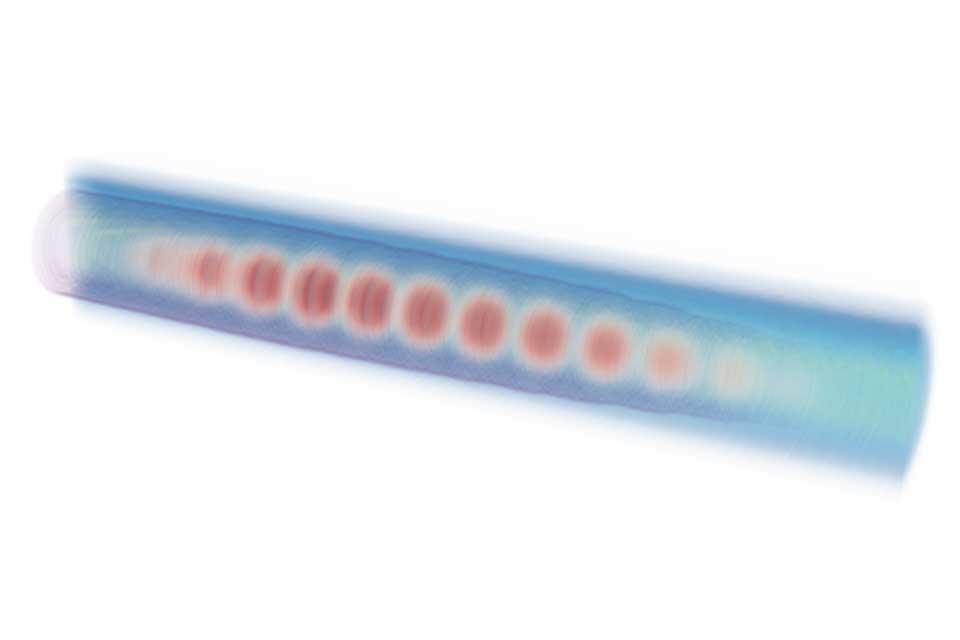Researchers at the University of Oxford’s Department of Physics have taken a step closer to demonstrating a new generation of high-repetition-rate laser-driven particle accelerators. These compact accelerators could drive myriad applications in science, medicine, and industry.
In a laser-driven plasma accelerator (LPA), a very intense laser pulse propagates through a plasma – an ionized gas. This drives a strong density wave in the plasma, which trails the laser pulse in a similar way to the wake following a moving boat. The electric fields within this plasma wave are 1,000 times stronger than those used in a traditional, radio-frequency accelerator. Hence these extreme fields can accelerate electrons to highly relativistic energies in just a few centimetres, whereas a conventional machine would be hundreds of metres long.
Laser-driven plasma accelerators can now routinely generate electron beams with energies comparable to today’s stadium-sized synchrotron and free-electron lasers. However, the number of applications of LPAs is limited by the low pulse repetition rate, and low “wall-plug” efficiency of the lasers used to drive them. In a recent paper published in Physical Review Research, researchers at Oxford have demonstrated a key step in a novel approach that could overcome this problem; their work enables LPAs to be driven by advanced industrial laser systems that operate at repetition rates at least 100 times greater than the lasers used today.
Resonant excitation
In order to drive a plasma wave the laser pulse must be shorter than the natural oscillation period of electrons in a plasma, which, for the conditions of interest, is around 100 femtoseconds (100 × 10-15 s). Very few lasers can deliver pulses of the required energy (a few joules) in such a short pulse, and hence almost all LPAs today are driven by titanium-doped sapphire lasers, which are able to meet these stringent demands. Unfortunately, however, these lasers are inefficient, and can only generate high-energy laser pulses at repetition rates of a few pulses per second.
To overcome this roadblock, the group at Oxford proposed a new concept: the plasma-modulated plasma accelerator (P-MoPA). This can take advantage of recently developed thin-disk lasers that can provide joule-scale laser pulses at repetition rates in the kilohertz range. The pulses from a thin-disk laser are too long (around 1 picosecond) to drive a plasma wave directly, and so a P-MoPA uses some tricks to modulate the long pulses.
A P-MoPA has three stages. In the first stage – the modulator – the spectrum of a long, high-energy thin-disk laser pulse is modulated by co-propagating it with the low amplitude plasma wave driven by a short, low-energy laser pulse. This process adds sidebands to the spectrum of the thin-disk pulse. In the second stage – the compressor – the spectrally-modulated thin-disk pulse is converted into a train of short pulses by passing it through an optically-dispersive system. Each pulse in the train will be short, and the pulses are spaced by the plasma period of the plasma in the modulator stage. Finally, in the third stage – the accelerator – the pulse train is focused into a plasma with the same density as the modulator. Each pulse in the train will drive a low-amplitude plasma wave and, since the pulses are spaced by the plasma period, these plasma waves add coherently to generate a large-amplitude plasma wave at the back of the pulse train. In this way the plasma wave is excited resonantly by a series of well-timed pushes, just as a child on a swing can reach large heights by a few well-timed pushes.
Demonstrating the accelerator stage
The new experiments were performed with the Astra-Gemini laser at the Central Laser Facility, near Oxford. To demonstrate the accelerator stage, the group devised a method to mimic the first two stages of a P-MoPA to generate a train of short laser pulses. This train, which had a total energy of around 1 J, was focused into a 110-mm-long plasma channel. The plasma channel, also developed by the Oxford group, is a kind of optical fibre made out of a cylindrical plasma, which continually focuses light as it propagates along its axis.
Excitation of a plasma wave is accompanied by a red-shift in the spectrum of the laser pulses, as energy is transferred to the plasma wave. In the new experiment, the researchers found, as expected, that the spectrum of the transmitted pulse train was strongly shifted to longer wavelengths when the density of the plasma channel was adjusted so that the plasma period matched the spacing of pulses within the pulse train. A detailed comparison of these results with theoretical simulations showed that, at resonance, the electric field within the plasma wave was in the range 3-10 GV/m. Electrons injected into this plasma wave would therefore gain an energy over the length of the accelerator stage that would be in the GeV range – comparable to the particle energy used in a synchrotron or free-electron laser.
This work is the first demonstration of resonant excitation of a plasma wave by a pulse train guided in a plasma channel. Commenting on the results, Professor Simon Hooker said, ‘These results were only possible through the huge effort over many years by many members of the Oxford group. It is very encouraging that we have been able to demonstrate a key step in the P-MoPA concept. Although there is much to do before the entire scheme can be demonstrated, we are looking forward to meeting the challenges that will arise as we work towards that goal.’
Resonant excitation of plasma waves in a plasma channel, AJ Ross et al, Physical Review Research 6 L022001 (2024), 3 April 2024

